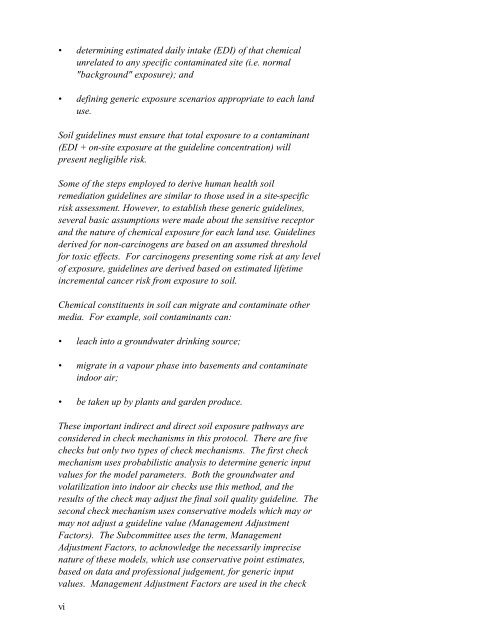Protocol for the Derivation of Environmental and Human ... - CCME
Protocol for the Derivation of Environmental and Human ... - CCME
Protocol for the Derivation of Environmental and Human ... - CCME
Create successful ePaper yourself
Turn your PDF publications into a flip-book with our unique Google optimized e-Paper software.
• determining estimated daily intake (EDI) <strong>of</strong> that chemical<br />
unrelated to any specific contaminated site (i.e. normal<br />
"background" exposure); <strong>and</strong><br />
• defining generic exposure scenarios appropriate to each l<strong>and</strong><br />
use.<br />
Soil guidelines must ensure that total exposure to a contaminant<br />
(EDI + on-site exposure at <strong>the</strong> guideline concentration) will<br />
present negligible risk.<br />
Some <strong>of</strong> <strong>the</strong> steps employed to derive human health soil<br />
remediation guidelines are similar to those used in a site-specific<br />
risk assessment. However, to establish <strong>the</strong>se generic guidelines,<br />
several basic assumptions were made about <strong>the</strong> sensitive receptor<br />
<strong>and</strong> <strong>the</strong> nature <strong>of</strong> chemical exposure <strong>for</strong> each l<strong>and</strong> use. Guidelines<br />
derived <strong>for</strong> non-carcinogens are based on an assumed threshold<br />
<strong>for</strong> toxic effects. For carcinogens presenting some risk at any level<br />
<strong>of</strong> exposure, guidelines are derived based on estimated lifetime<br />
incremental cancer risk from exposure to soil.<br />
Chemical constituents in soil can migrate <strong>and</strong> contaminate o<strong>the</strong>r<br />
media. For example, soil contaminants can:<br />
• leach into a groundwater drinking source;<br />
• migrate in a vapour phase into basements <strong>and</strong> contaminate<br />
indoor air;<br />
• be taken up by plants <strong>and</strong> garden produce.<br />
These important indirect <strong>and</strong> direct soil exposure pathways are<br />
considered in check mechanisms in this protocol. There are five<br />
checks but only two types <strong>of</strong> check mechanisms. The first check<br />
mechanism uses probabilistic analysis to determine generic input<br />
values <strong>for</strong> <strong>the</strong> model parameters. Both <strong>the</strong> groundwater <strong>and</strong><br />
volatilization into indoor air checks use this method, <strong>and</strong> <strong>the</strong><br />
results <strong>of</strong> <strong>the</strong> check may adjust <strong>the</strong> final soil quality guideline. The<br />
second check mechanism uses conservative models which may or<br />
may not adjust a guideline value (Management Adjustment<br />
Factors). The Subcommittee uses <strong>the</strong> term, Management<br />
Adjustment Factors, to acknowledge <strong>the</strong> necessarily imprecise<br />
nature <strong>of</strong> <strong>the</strong>se models, which use conservative point estimates,<br />
based on data <strong>and</strong> pr<strong>of</strong>essional judgement, <strong>for</strong> generic input<br />
values. Management Adjustment Factors are used in <strong>the</strong> check<br />
vi
















